Chapter 4 - The Library of Iberian Resources Online
Chapter 4 - The Library of Iberian Resources Online
Chapter 4 - The Library of Iberian Resources Online
You also want an ePaper? Increase the reach of your titles
YUMPU automatically turns print PDFs into web optimized ePapers that Google loves.
Albalat referred in 1258. For a while Raimundo's statutes and the Summa have in common a number <strong>of</strong><br />
phrases which the Paris statutes lack, (104) the former do not contain the distinctive passages on the<br />
sacraments and patronage <strong>of</strong> the friars which appear in the 1241 Summa. (105) <strong>The</strong> Lérida statutes bear<br />
no date, but assuming that they were issued before 1241 -- an assumption for which there is some<br />
support (106) -- it may be suggested that they were based on an earlier version <strong>of</strong> the Summa<br />
promulgated by Pedro while he was bishop <strong>of</strong> Lérida -- which we may identify as Summa I -- and,<br />
further, that this version had incorporated Eudes de Sully's statutes without adding very much fresh<br />
material. Within this hypothesis the final section <strong>of</strong> the Lérida statutes -- for almost all <strong>of</strong> which no<br />
parallel passages may be found either in the Paris statutes or in the Summa -- would be regarded as<br />
comprising Bishop Raimundo's [74] own original contribution. (107) But this is only a hypothesis. <strong>The</strong><br />
terrain is notoriously difficult to negotiate; delusions are legion; a single manuscript as yet<br />
undiscovered might easily upset it entirely; and -- most substantially -- no manuscript <strong>of</strong> Summa I has<br />
been produced.<br />
Leaving aside the putative Summa I we are on firmer ground with the Summa promulgated at<br />
Barcelona in October 1241, the earliest known example in the Spanish peninsula <strong>of</strong> the liber sinodalis<br />
which contemporaries regarded as the hallmark <strong>of</strong> an outstandingly zealous prelate. (108) In October<br />
1261 the clergy <strong>of</strong> the diocese <strong>of</strong> Valencia were ordered to furnish themselves with copies <strong>of</strong> the<br />
Summa by the following Christmas, (109) and though neither the Barcelona nor the Tarragona version<br />
contains explicit pro<strong>of</strong> that it had any such didactic purpose in those places, it may nonetheless be<br />
assumed that 'las escelentes constituciones sobre sacramentos, vida clerical, etc.' which Villanueva<br />
noticed at Barcelona but did not bother to analyse, were promulgated as such by Pedro himself. (110)<br />
<strong>The</strong> Summa is not a strikingly original work. It is far from being a landmark in the literature <strong>of</strong> pastoral<br />
theology. Like the Lérida statutes, it leans heavily on Eudes de Sully, and such texts <strong>of</strong> the Fourth<br />
Lateran Council as are accorded mention are remembered not in the terminology <strong>of</strong> 1215 but in that <strong>of</strong><br />
1229 as they had been transmitted by John <strong>of</strong> Abbeville at the Lérida Council. (111) Yet though the<br />
content <strong>of</strong> the Summa was only very occasionally Pedro's own, positive credit may be given him for the<br />
pattern which he imposed on material not his own. It is the arrangement <strong>of</strong> the Summa that<br />
distinguishes it from its main source. Whereas the Lérida statutes had followed the Paris statutes<br />
indiscriminately and had departed from that model only in their pell-mell rearrangement <strong>of</strong> the jumble<br />
<strong>of</strong> miscellaneous communia praecepta, (112) the Summa conflates the old material, [75] introduces some<br />
that is new, stresses that which Pedro deemed in need <strong>of</strong> being stressed, and contrives a brief and<br />
orderly handbook containing a section on each <strong>of</strong> the seven sacraments -- in a different sequence from<br />
that previously adopted -- introduced by instructions De ordinatione sinodi, which depart hardly at all<br />
from Eudes de Sully; and followed by two further sections -- Qualiter Christiani orare debent, based<br />
on nos 10 and 32 <strong>of</strong> the communia praecepta, and De vita et honestate clericorum, which also makes<br />
use <strong>of</strong> the communia praecepta as well as <strong>of</strong> additional fresh material. Even when the Paris statutes are<br />
most closely followed Pedro adapts them to his own requirements and sub-edits freely. Such is the case<br />
in the sections on Baptism, Confirmation and Extreme Unction. In the first, the lapidary sentences are<br />
shuffled; further details about godparents are supplied; it is explained that baptism by the child's<br />
parents is permitted (which neither the Paris nor the Lérida statutes had mentioned although the<br />
practice was tolerated elsewhere at an earlier date) ; (113) and provision for the baptism <strong>of</strong> an infant<br />
delivered by caesarean section -- with which both the other sets <strong>of</strong> statutes had dealt (114) -- is omitted.<br />
Further on, the special efficacy <strong>of</strong> Confirmation is stressed, (115) and the point is made that neither that<br />
sacrament nor Baptism was to be repeated, even if the Christian had meanwhile embraced the Jewish or<br />
Moorish faith -- a problem <strong>of</strong> immediate concern for the parish clergy <strong>of</strong> Southern Aragon though not<br />
for those <strong>of</strong> Northern France. Likewise Pedro addresses himself to the sacrament <strong>of</strong> Extreme Unction
















